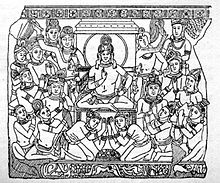Śuddhodana: Difference between revisions
No edit summary |
|||
| Line 23: | Line 23: | ||
=== Birth of Buddha === |
=== Birth of Buddha === |
||
Lord Gautam Buddha (Siddhartha Gautam) was born in [[Lumbini]], [[Nepal]] |
Lord Gautam Buddha (Siddhartha Gautam) was born in [[Lumbini]], [[Nepal]]. Once the [[Rishi|sage]] [[Asita]] visited Siddhartha when he was a baby and was surprised when the infant [[prince]] placed his feet on top of the sage’s head. After Asita examined the prince’s feet, he kneeled and paid [[homage]] to the infant. Suddhodana copied his action. |
||
Siddhartha later received his name from the Five Forest Brahmana, [[Kaundinya]], Mahaanaama, [[Baspa Valley|Baspa]], Asvajita, and Bharika, who later became Buddha's companions during his ascetic practices and his first five followers after his [[Enlightenment (spiritual)|enlightenment]]. |
Siddhartha later received his name from the Five Forest Brahmana, [[Kaundinya]], Mahaanaama, [[Baspa Valley|Baspa]], Asvajita, and Bharika, who later became Buddha's companions during his ascetic practices and his first five followers after his [[Enlightenment (spiritual)|enlightenment]]. |
||
Revision as of 15:25, 29 September 2013
Śuddhodana | |
|---|---|
 Śuddhodana and his court | |
| Spouse(s) | Maya Mahapajapati Gotami |
| Children | Gautama Buddha Princess Nanda Prince Nanda |
| Parent(s) | Sihahanu Kaccanā |
| Part of a series on |
| Buddhism |
|---|
 |
King Suddhodana (Sanskrit: Śuddhodana; Japanese: 浄飯王 Jōbon-ō) was the father of Gautama Buddha.[1] He was a leader of the Shakya people, who lived in Kapilvastu and was a righteous king.
Family
Suddhodana’s father was King Sihahanu.Mother of Śuddhodana was Queen Kaccanā.
Śuddhodana’s son Siddhartha married his cousin Yasodharā, daughter of Suppabuddha and his father’s sister.
Śuddhodana’s consorts Maya and Mahapajapati Gotami were Buddha’s mother and stepmother.
Other children of Śuddhodana were Princess Sundari Nanda and Prince Nanda.[2]
Biography
Birth of Buddha
Lord Gautam Buddha (Siddhartha Gautam) was born in Lumbini, Nepal. Once the sage Asita visited Siddhartha when he was a baby and was surprised when the infant prince placed his feet on top of the sage’s head. After Asita examined the prince’s feet, he kneeled and paid homage to the infant. Suddhodana copied his action.
Siddhartha later received his name from the Five Forest Brahmana, Kaundinya, Mahaanaama, Baspa, Asvajita, and Bharika, who later became Buddha's companions during his ascetic practices and his first five followers after his enlightenment.
It was prophesied by the Five Forest Brahmana that Siddhartha would become a great chakravartin or "universal monarch". However, if he saw four signs—an old man, a sick man, a cadaver and a monk—he would instead become a great sage. Kaundinya disagreed with the other four Brahmana and predicted that Siddhartha would become a Buddha. After hearing this, Suddhodana tried to keep Siddhartha shielded from the outside world so that he would never see the four signs and become a powerful ruler instead. However, his plan did not succeed and Siddhartha became a sage, leaving luxurious palace life for a humble journey in the search of enlightenment.
Later life
Śuddhodana lamented his son’s departure and spent considerable effort attempting to locate him. Years later, after word of Siddhartha’s enlightenment reached Śuddhodana, he sent a messenger with 10,000 companions to invite Siddhartha back to the Shakya land. The Buddha proceeded to preach to the messenger and all 10,000 companions, who in turn decided to join the Sangha.
Śuddhodana then sent a close friend of Siddhartha, Kaludayi, to invite him to return. Kaludayi also chose to become a monk, but kept his word to invite the Buddha back to his homeland. The Buddha accepted his father's invitation and returned to visit his homeland. During this visit, he preached the Dharma to Suddhodana.
Many years later, when the Buddha heard of Śuddhodana's impending death, he once again returned to his homeland and preached further to Śuddhodana at his deathbed.
References
- ^ In the Pāli Canon, there are only two discourses that explicitly reference Suddhodana: DN 14, Mahāpadāna Sutta, and in the versified prologue of Sn 3.11, Nālaka Sutta. In each of these discourses, Suddhodana is represented simply as the Buddha's father and as a Sakyan King. For a translation of the latter discourse, see Thanissaro, 1998.
- ^ Dictionary of Buddhism, Keown, Oxford University Press, ISBN 0-19-860560-9
External links
- Immediate family of Shuddhodana
- Why was the Sakyan Republic Destroyed? by S. N. Goenka (The following is a translation and adaptation of a Hindi article by S. N. Goenka published by the Vipassana Research Institute in December 2003.)
